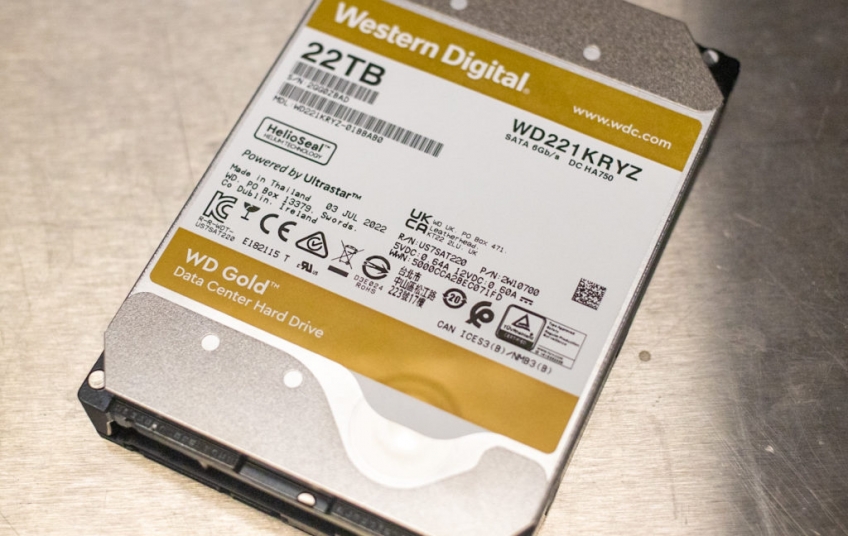Initially announced back in May, the WD Gold 22TB is the company’s newest CMR HDD with OptiNAND technology. This massive capacity model is specifically designed to lower TCO for organizations, as they can add more capacity to their data centers without affecting the physical footprint (or have the same capacity at a lower physical footprint).
As a result, it will also help reduce required rack space and lower network, power, cooling, and cabling costs. Besides the new 22TB model, the WD Gold line is available in capacities as low as 1TB, making them ideal for a wide range of demanding storage environments.
Massive Capacity and Impressive Performance Potential
WD sent eight 22TB Gold drives for us to review, which makes both the largest and fastest hard disk drives we’ve had in our lab (WD has indicated that the 22TB WD Gold is capable of reaching 291MB/s, which is quick for a HDD). So, you can imagine how excited we were to slide them into one of our Supermicro servers, put them through our gauntlet of tests, and see what they are capable of outputting.
While many think that SSDs are the better storage option, HDDs still have a lot of life left and truth be told, power the cloud. Tossing 100 of these drives in a JBOD for instance will show some pretty impressive performance (roughly 30GB/s). As a result, the WD Gold 22TB HDDs are ideal for MSPs, cloud providers, and enterprises that need to have a massive amount of data conveniently available.
WD Gold 22TB Advanced Technology
WD’s unique OptiNAND-enabled ArmorCache technology combines the performance of write cache enabled mode with the data protection of write cache disabled mode without having to compromise by choosing between the two.
Specifically, the 22TB will be a lot faster in random write at longer transfer lengths (that is, 256KB-2MB transfer length compared to the 4KB transfer length). In addition, when the drive is operating in WCE (write-cache enabled) mode, the DRAM cache will ensure that data is safely written when unexpected power outages occur. WCD (write-cache disabled) mode means a larger cache size guarantees more data will be safely written upon power loss, and the drive operates with WCE-equivalent performance.
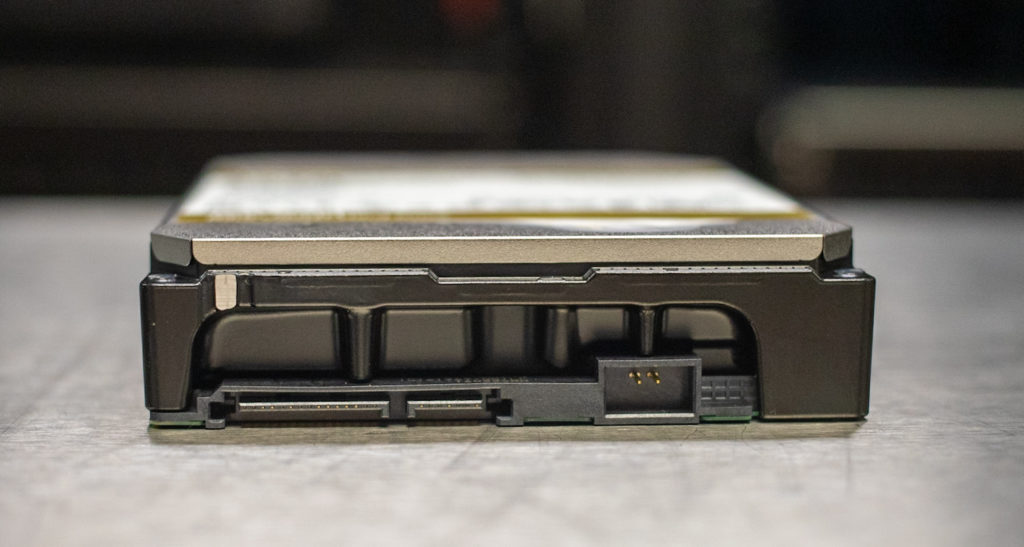
The WD Gold 22TB features the same 2.5-million-hour MTBF rating as the other higher capacity models as well as vibration protection technology and a low power draw due to HelioSeal technology. As far as power management goes, the 22TB model has a slightly higher average operational draw at 7.1W compared to the 20TB model; however, its idling is an improved 5.7W.
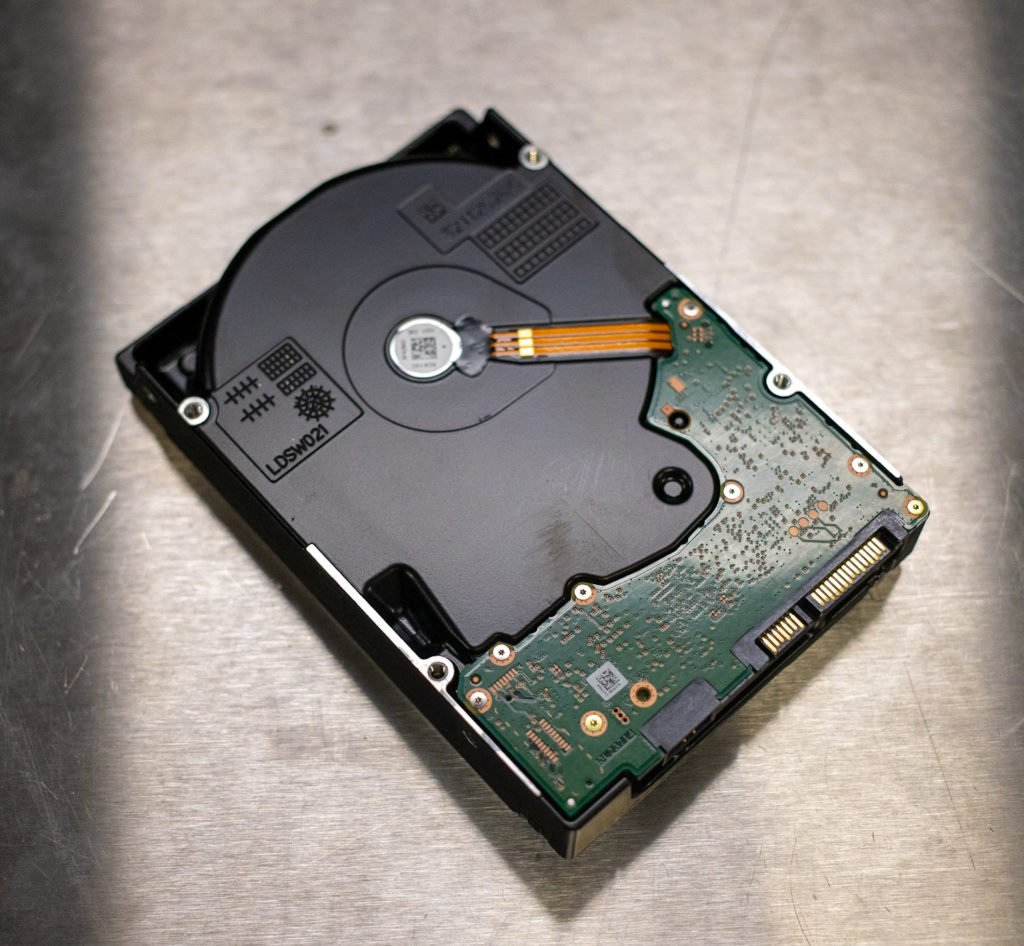
Backed by a 5-year warranty, the 22TB WD Gold drive goes for roughly $600 MSRP in quantity of one.
WD Gold HDD 22TB Specifications
Model Number |
WD221KRYZ |
Form factor |
3.5-inch |
Interface |
SATA 6 Gb/s |
512n / 512e user sectors per drive4 |
512e |
Formatted capacity |
22TB |
OptiNAND technology |
Yes |
RoHS compliant |
Yes |
Performance |
|
Data transfer rate (max Sustained) |
291MB/s |
RPM |
7200 |
Cache |
512MB |
Power Management |
|
Average power requirements (W) |
|
Operational |
7.1W |
Idle |
5.7W |
Power efficiency index (W/TB, idle) |
0.26 |
Reliability |
|
MTBF (hours, projected) |
2,500,000 |
Annualized Failure Rate2 (AFR, %) |
0.35 |
Limited Warranty |
5 years |
Environmental |
|
Operating temperature |
5°C to 60°C |
Non-operating temperature |
-40°C to 70°C |
Shock (Read/Write)Operating (half-sine wave, 2ms) |
40G/40G |
Non-operating (half-sine wave, 2ms) |
200G |
Acoustics (average) |
|
Idle Mode |
20 dBA |
Seek Mode |
32 dBA |
Physical Dimensions |
|
Height (max) |
26.1mm |
Length (max) |
147.0mm |
Width (± .01 in.) |
101.6mm |
Weight |
1.47 lb (.67 kg)± 10% |
WD Gold HDD 22TB and TrueNAS
Formerly FreeNAS, TrueNAS CORE (which is what we used for our WD Gold 22TB Supermicro configuration) is the comprehensive storage OS that allows users to build professional-grade storage systems themselves. As a result, you can a TrueNAS-powered server in a range of data-intensive use cases without having to worry about software costs. All you need to do is install it onto the server (or a VM) and you’re all set.
The Dashboard displays at-a-glance information and access to all TrueNAS management options.
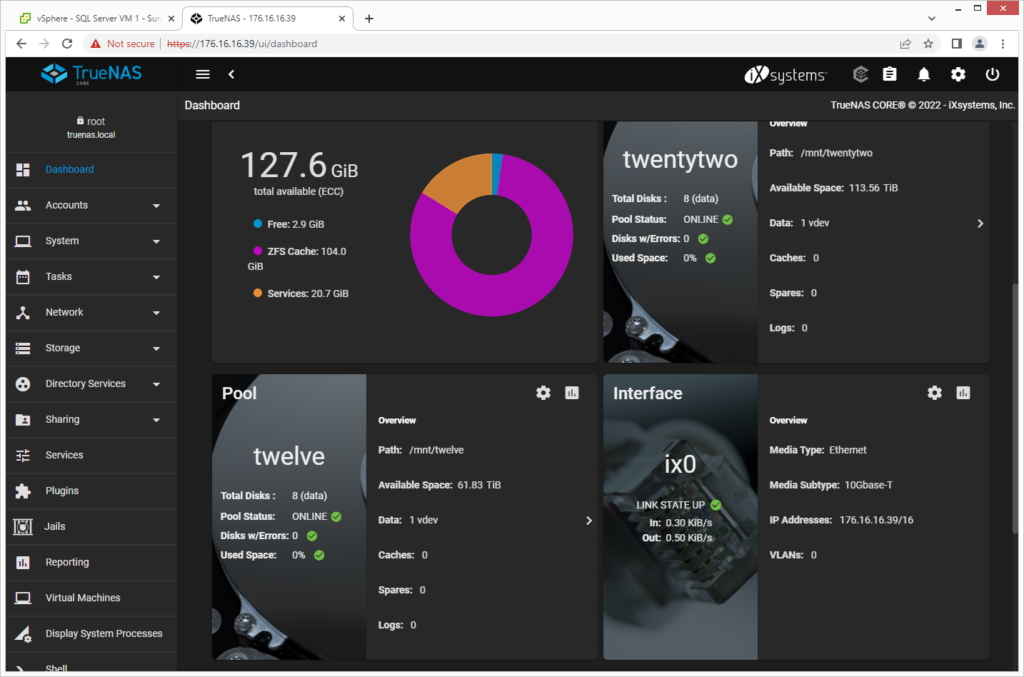
Here, you can information about the storage pools, including the name, type, and available space.
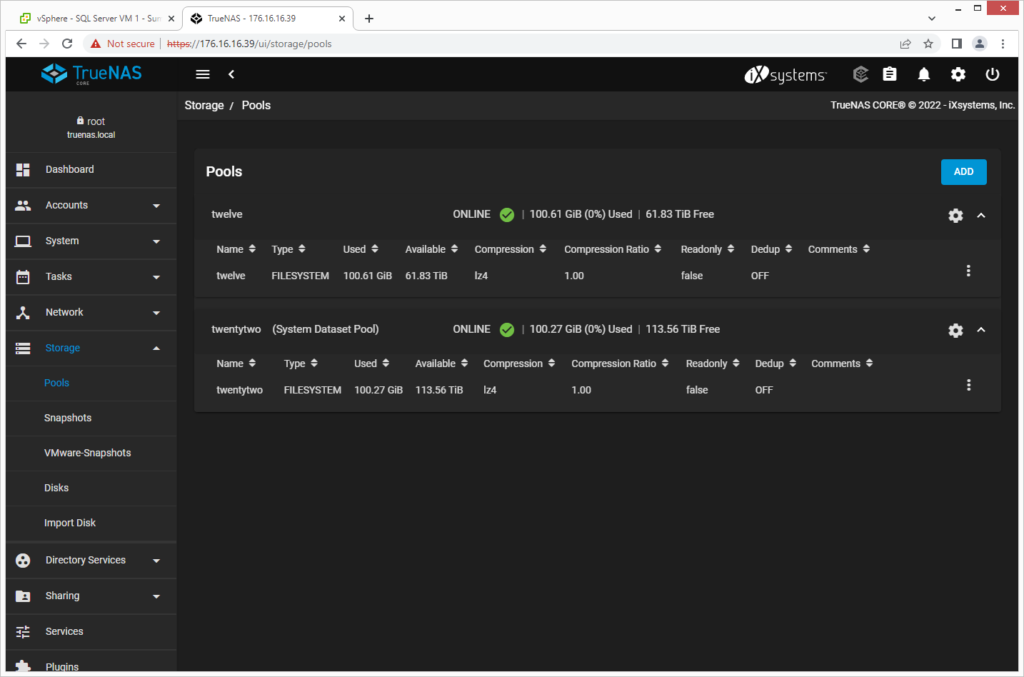
WD Gold HDD 22TB Performance
Enterprise Synthetic Workload Analysis
To test the 22TB Gold HDD performance, we installed eight of them into our 36-bay Supermicro Storage SuperServer (SSG-540P-E1CTR36H) with TrueNAS installed (RAID2Z) and compared it to the WD Ultrastar 12TB HDD for reference. Networking connectivity was provided through dual 10GbE connections. These were also a bottleneck for sequential workloads. All TrueNAS pool settings were kept default, which included compression enabled and deduplication disabled.
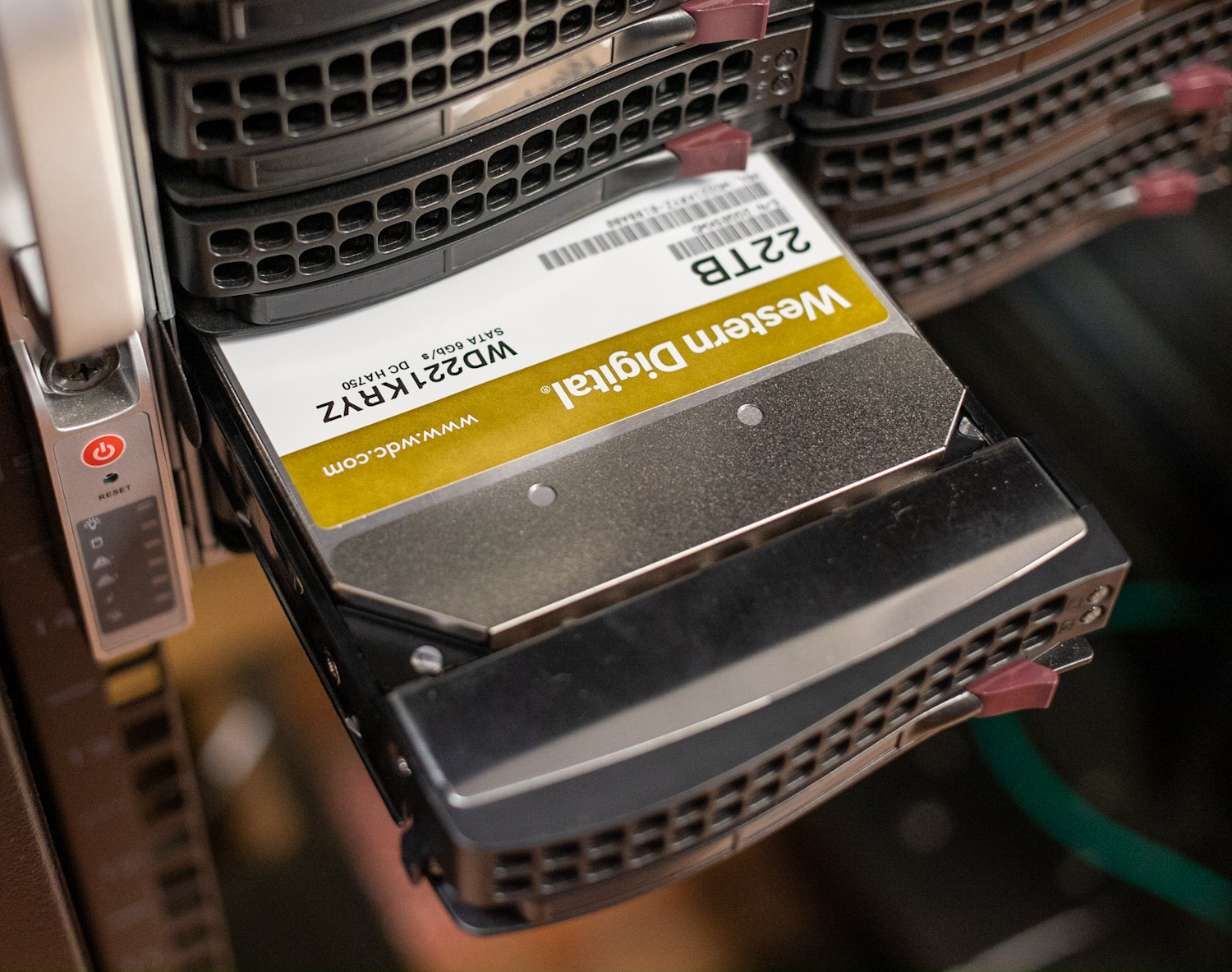
Our enterprise hard drive benchmark process preconditions each drive-set into steady-state with the same workload the device will be tested with under a heavy load of 16 threads, with an outstanding queue of 16 per thread. The device is then tested in set intervals in multiple thread/queue depth profiles to show performance under light and heavy usage. Since hard drives reach their rated performance level very quickly, we only graph out the main sections of each test.
Preconditioning and Primary Steady-State Tests:
-
Throughput (Read+Write IOPS Aggregate)
-
Average Latency (Read+Write Latency Averaged Together)
-
Max Latency (Peak Read or Write Latency)
-
Latency Standard Deviation (Read+Write Standard Deviation Averaged Together)
Our Enterprise Synthetic Workload Analysis includes four profiles based on real-world tasks. These profiles have been developed to make it easier to compare to our past benchmarks, as well as widely-published values such as max 4K read and write speed and 8K 70/30, which is commonly used for enterprise drives.
4K
-
100% Read or 100% Write
-
100% 4K
8K 70/30
-
70% Read, 30% Write
-
100% 8K
128K (Sequential)
-
100% Read or 100% Write
-
100% 128K
Our first throughput test measures 4K random performance. Here, the WD Gold 22TB posted 107,303 IOPS in reads and 4,730 IOPS write (SMB). In comparison, the 12TB WD Ultrastar was able to reach 107,884 IOPS read and 5,600 IOPS write.
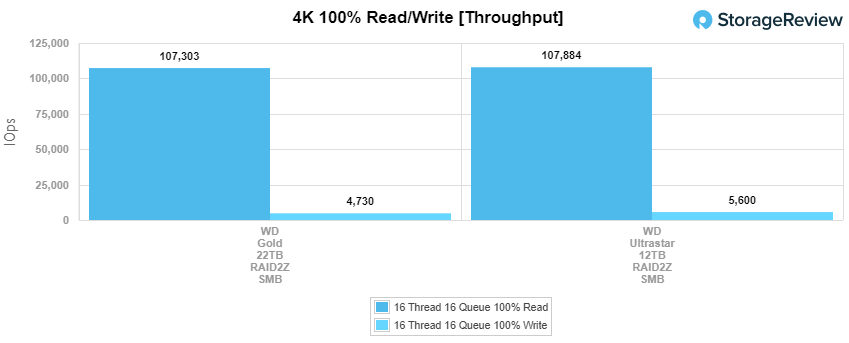
In average latency, the WD Gold hit read and writes of 2.384ms and 54.11ms, respectively, while the 12TB WD Ultrastar posted 2.372ms read and 45.7ms write.
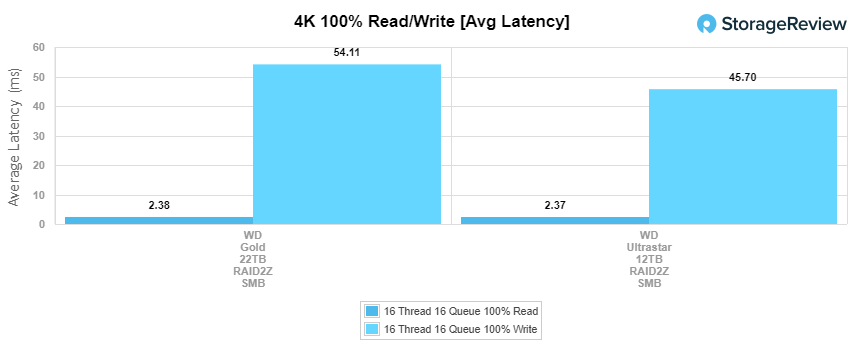
Moving on to the max latency, the WD Gold recorded just 9.539ms read and 153ms write. In comparison, we saw the 12TB WD Ultrastar hit 403.113ms read and 114ms write.
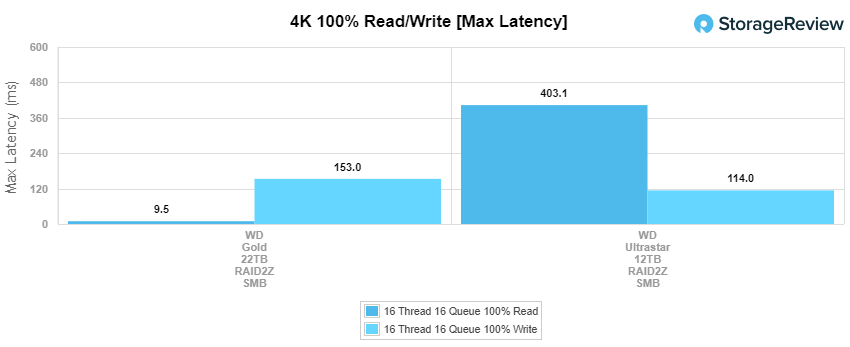
For standard deviation, the WD Gold hit 1.853ms read and 27.13ms write, while the Ultrastar recorded reads and writes of 2.114ms and 9.76ms, respectively.
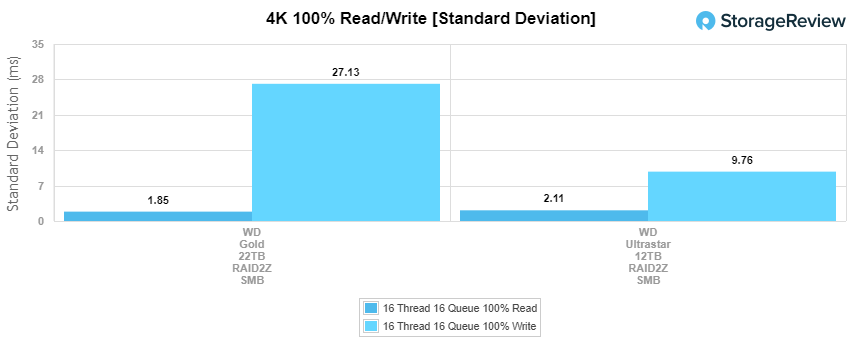
Our next benchmark subjects the drives to 100% read and write activity at 8K sequential throughput. Here, the 22TB WD Gold drive posted 109,454 IOPS read and 105,577 IOPS write in SMB, while the WD Ultrastar hit 108,655 IOPS read and 104,077 IOPS write in iSCSI.
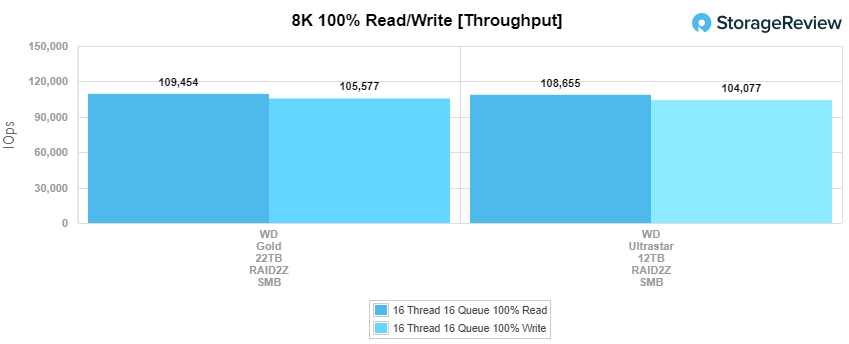
Our next test shifts focus from a pure 8K sequential 100% read/write scenario to a mixed 8K 70/30 workload, which will demonstrate how performance scales in a setting from 2T/2Q up to 16T/16Q. In all tests except max latency, the WD Gold 22TB started off a bit behind the 12TB WD Ultrastar in the initial stages; however, it showed noticeably better-sustained performance when approaching the terminal queue depths.
For our first test, which measures throughput, the WD Gold had a range of 14,333 IOPS to 26,882 IOPS in SMB while 12TB WD Ultrastar posted a range of 16,872 IOPS to 18,789 IOPS.
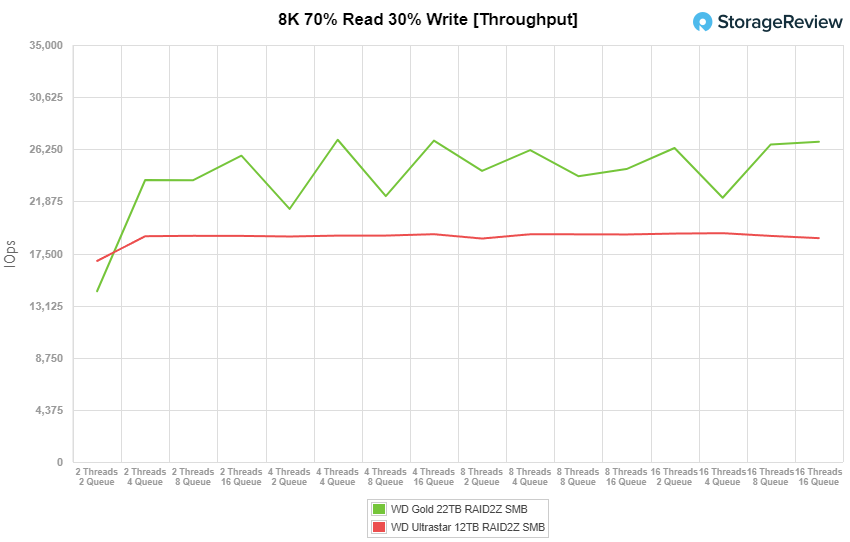
With average latency at 8K 70/30, the 22TB Gold model saw great overall results again; it posted 0.27ms through 9.51ms in SMB, while the 12TB Ultrastar recorded a range of 0.23ms through 13.62ms.
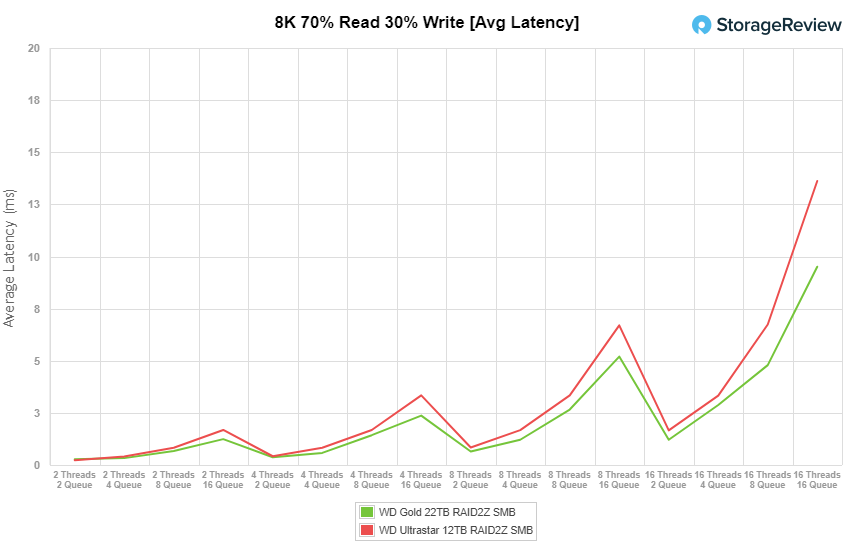
Moving on to max latency numbers, the 22TB WD Gold had a range of 10ms to 40.2ms while the 12TB WD Ultrastar showed 10.01ms through 87.95ms.
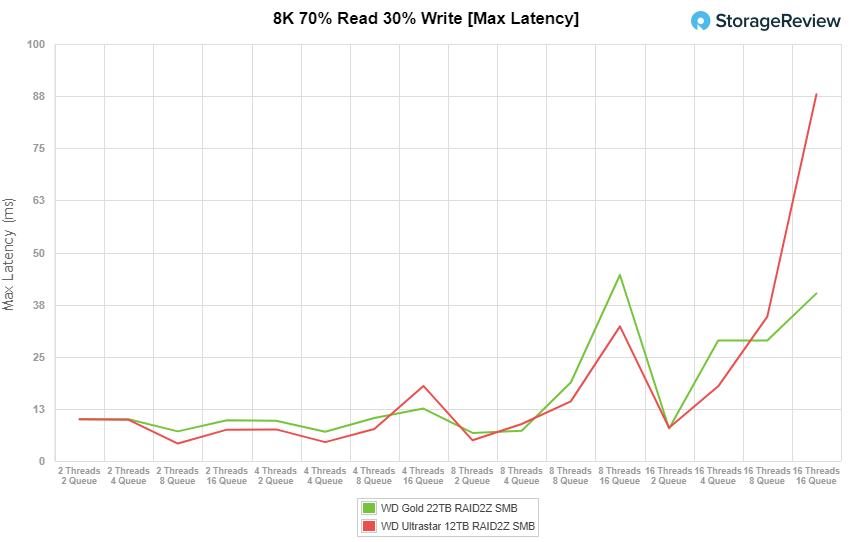
For our standard deviation latency results, the 22TB Gold model hit 0.09ms through 4.97ms (SMB). The 12TB WD Ultrastar fell behind in the terminal queue depths again, posting a range of 0.05ms to 7.22ms.
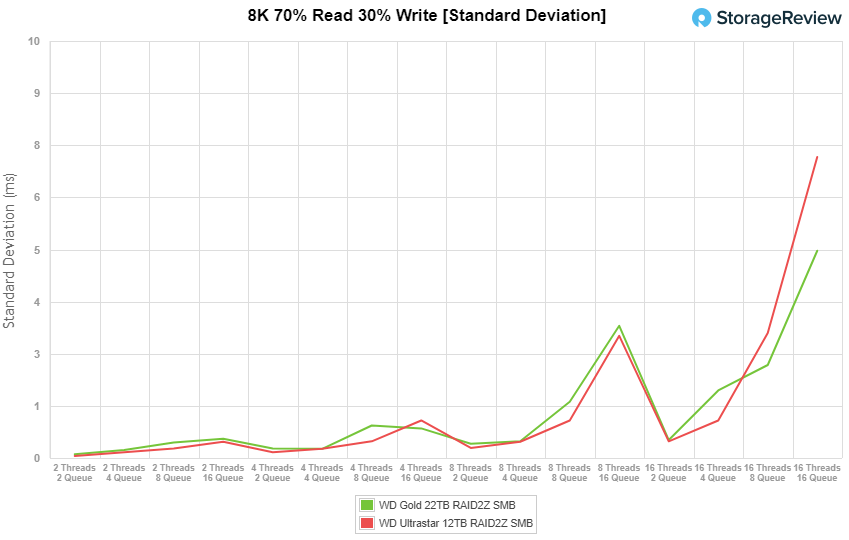
Our last test is the 128K benchmark, a large-block sequential test showing the highest sequential transfer speed. Here, both the 12TB Ultrastar and 22TB Gold model hit 2.31GB/s in read performance (down to the decimal point). There was a slight difference in write performance, however, both drives essentially hit the 2.31GB/s mark as they did in reads. This bandwidth was the dual 10GbE connection bottleneck out of the server.
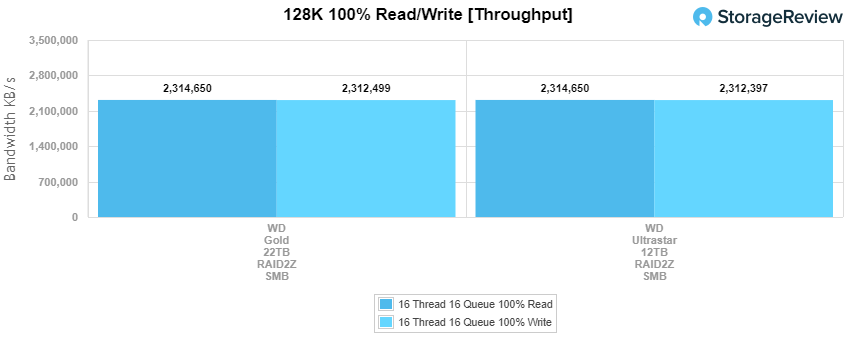
Conclusion
The WD Gold 22TB is a great addition to the company’s already extensive enterprise hard drive lineup, offering the industry’s highest areal density at 2.2TB per platter (alongside the WD Red for NAS solutions and WD Purple for surveillance setups). The extra 2TB in capacity over the 20TB HDDs certainly adds up if you’re using pallet-fulls of these drives in your data center.
This CMR-based drive also boasts a 2.5-million-hour MTBF and features OptiNAND technology, energy-assisted PMR (ePMR), triple-stage actuator (TSA), HelioSeal, and is backed by a five-year warranty.
For performance, we installed eight of these drives in our 36-bay Supermicro Storage SuperServer (configured in SMB) and compared them alongside a set of WD’s 12TB Ultrastar HDDsfor reference. We saw some pretty great throughput across our benchmarking, including 107,303 IOPS in reads and 4,730 IOPS write in random 4K, 109,454 IOPS read, and 105,577 IOPS during our 100% read and write activity at 8K sequential workload, a range of 14,333 IOPS to 26,882 IOPS for our mixed 8K 70/30 workload, and 2.31GB/s in both read and writes.
Our sequential figures, while at the point of 10GbE saturation for our two links, are also pretty close to what eight HDDs can push out if they are running with 290MB/s each.
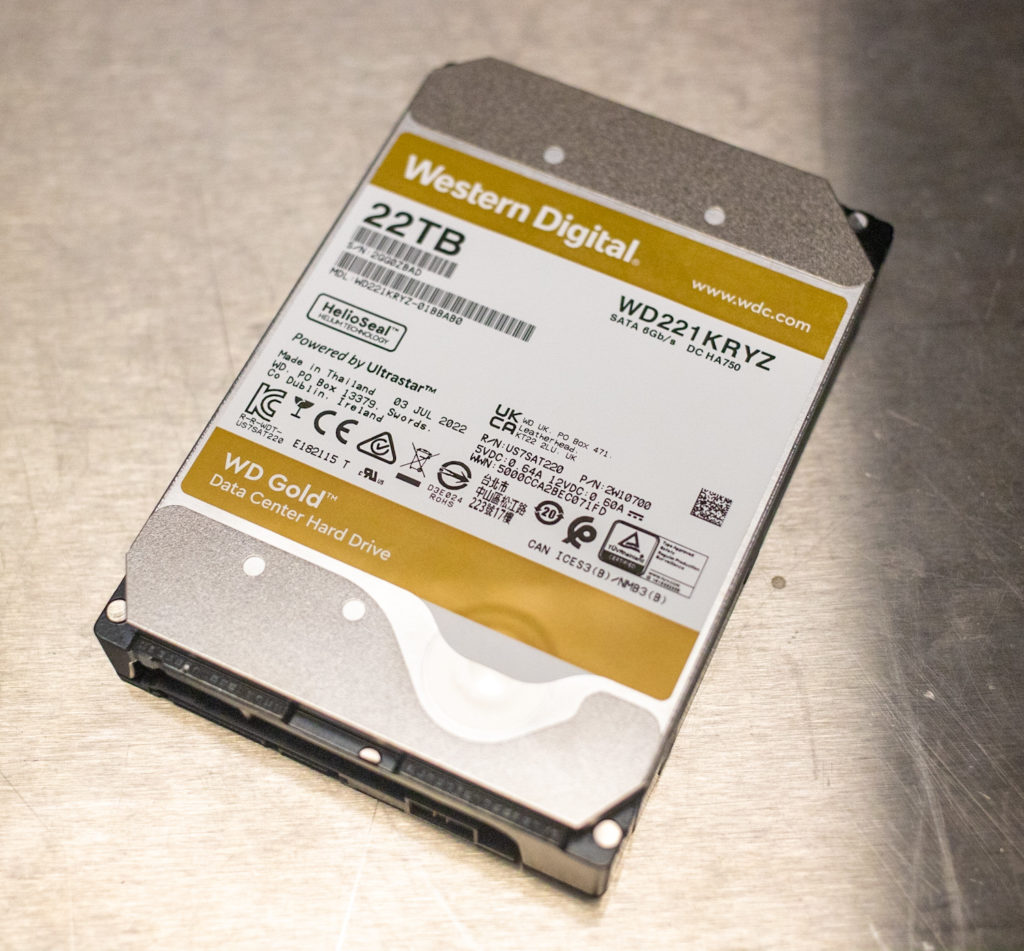
With great performance and an industry-best CMR capacity point, the addition of the 22TB model to WD’s Gold line of HDDs makes this already comprehensive lineup even more impressive, giving organizations more flexibility for their data center storage systems. Fresh drives like this will carry a price premium, but it should be noted that even in orders of one drive at MSRP, these start at less than where we saw 18TB and 20TB drives launch.
Overall, the WD Gold 22TB HDDs aren’t trying to break a ton of new ground, they don’t really need to. Data availability is the name of the game for HDDs, but the 22TB Golds do offer a good performance profile as well. The WD Gold 22TB HDDs should find plenty of practicality for any application where data density and availability are the primary factors.



